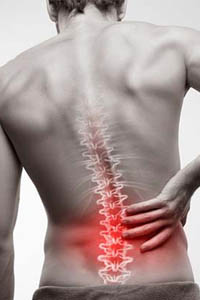There is a reason for this as with everything else, and it makes sense once you understand the reason. First of all, your back doesn’t really “go out”. It is still inside your body and the vertebra is still in your spine. What is really happening is that the vertebra has shifted from its normal position as it relates to the vertebrae above and below. It is also fixated, or stuck, in this wrong position. It cannot move as it should with its neighbors above and below and with the rest of the spine.
So why is the vertebra stuck in the wrong position? Think about this. What holds the bones together at the joints? Ligaments, and in the case of the spine, the discs (the top vertebra under your skull and sacroiliac joints in the pelvis don’t have discs).
Healthy ligaments and discs hold the vertebrae in position while allowing and controlling a certain normal range of movement between vertebrae where they meet at the discs and posterior joints. If the disc and ligaments are damaged and weak, they cannot maintain normal position and movement of the vertebra with its neighbors above and below. So there is a weakness of the critical support tissues.
Muscles help stabilize the spine and muscles move the bones, but they cannot duplicate the job the disks and ligaments do. Each layer of support is important or failure may occur. Recent studies have shown the importance of a small involuntary muscle, called the multifidus muscle. We always knew they were important, but we’re finding the multifidus is even more important than we thought. The multifidus muscles are weak, and usually atrophied (shrunk) on people with back problems, especially chronic back pain. That makes sense, because if a vertebra cannot move this muscle does not work.
The multifidus fires to help stabilize the spinal joints in the back, called the posterior joints. This is more crucial if the dick and ligaments are weak. But if you move in a position that places a load, or an overload, on a weak joint, the much needed multifidus muscle doesn’t do its job, or cannot do it.
What studies have also shown is that even if the multifidus muscle fires, it fires too late. Thus, the weak area is still not protected with that extra layer of support. The result is that the support tissues fail and the vertebra shifts. Why does the multifidus muscle fire too late? Good question, and there’s a reason for that too.
Whenever the spine is subluxated, which is the term we use for a vertebra stuck in the wrong position, nerves are irritated, and “sensors” embedded in the ligaments, disks, muscles, tendons, etc. fire in an erratic and confused manner. Some muscles are shut down, others are over-activated. Its like everything is in a panic state. Your brain receives these necessary messages so it can process them and then accurately orchestrate all the proper muscle contractions necessary for you to move and to stabilize the joints while you move. But the brain is receiving corrupt information and cannot respond correctly.
So we have a damaged and weakened disk and ligaments, they need help anyway but now even more. Then the muscles that should help are weak and shriveled up themselves, and if they do respond they are too late. Therefore, if you move just right you may be putting this weak area in a compromised position and your back “goes out”.
What is the answer? That’s easy. If the vertebra is subluxated, or stuck in the wrong position, it is irritating nerves and causing abnormal signals to be sent to the brain. First of all we must adjust the vertebra to correct this abnormal state. The adjustment also reduces the abnormal wear and tear strain on the disc and ligaments that creates additional damage and weakness. With the communication restored you can now do exercises that provide “friendly” stress to help strengthen the muscles, like the multifidus since it is now able to work, and the sensors and the brain can learn the new and correct pattern. In the mean time it helps if you can avoid stressful postures, movements, and positions that aggravate and reproduce your problem.
To find out if we can help you when your back “goes out,” give us a call at (918) 664-3571 to schedule a free consultation.






